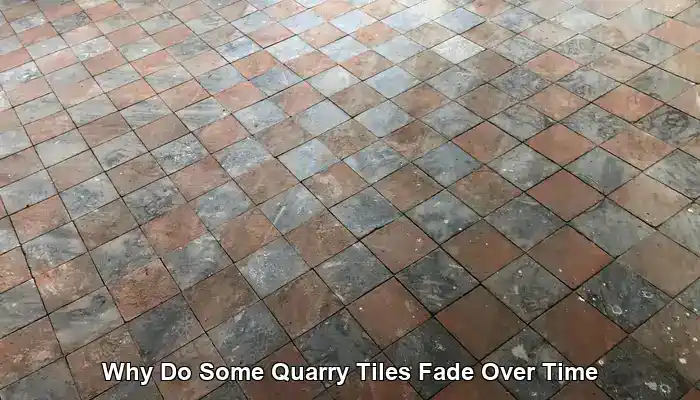
Quarry tiles are renowned for their outstanding durability, natural aesthetics, and everlasting appeal. These robust, unglazed ceramic tiles are perfect for a rustic kitchen or as a base for a lively patio, designed to withstand heavy foot traffic and challenging environments. Nevertheless, homeowners and property managers often notice a gradual <a href=”https://limitsofstrategy.com/grout-fading-reasons-for-vibrancy-differences-explained/”>fading</a> of colour over time, which can sometimes be uneven or dramatic. This change can be perplexing, particularly when vibrant reds, warm browns, or deep terracotta shades evolve into pale, patchy, or dull appearances.
The gradual fading of quarry tiles is more than just a visual issue; it often signals underlying wear, environmental stress, or potential chemical damage. Outdoor tiles face continuous exposure to environmental elements—such as rain, frost, and fluctuating temperatures—that gradually deteriorate their surface. The freeze-thaw cycle, in particular, creates micro-cracks and surface flaking, revealing lighter inner layers with coarser textures. Conversely, indoors, the situation is intricate as high foot traffic gradually wears down the tile’s pigmented surface, exposing the inner material, which typically contains larger particles and varied mineral hues. This natural layering indicates that once the surface integrity is compromised, significant changes in colour and texture are likely to ensue.
Beyond physical wear, exposure to chemicals plays a critical role in the fading process. Strong cleaning agents, particularly those that are acidic or alkaline, can weaken protective sealers and strip away coatings. Over time, this exposure makes the tile more vulnerable to staining, efflorescence (the formation of salt deposits that lighten the surface), and the accumulation of dirt in new pits and abrasions. These combined factors contribute to a faded, uneven appearance that detracts from the tile’s original charm and character.
Gaining insight into the factors contributing to quarry tile fading is an essential first step towards preserving their character and enhancing their longevity. In this extensive guide, we will explore the environmental, mechanical, and chemical elements that lead to fading—both indoors and outdoors—and provide actionable strategies for prevention and restoration. Whether you are maintaining a historic floor or aiming to keep your tiles in immaculate condition, this guide will equip you with the knowledge to comprehend the subtle science behind quarry tile wear.
Top Recommended Products for Daily Maintenance of Quarry Tiles

Fila Pro Floor Cleaner
|
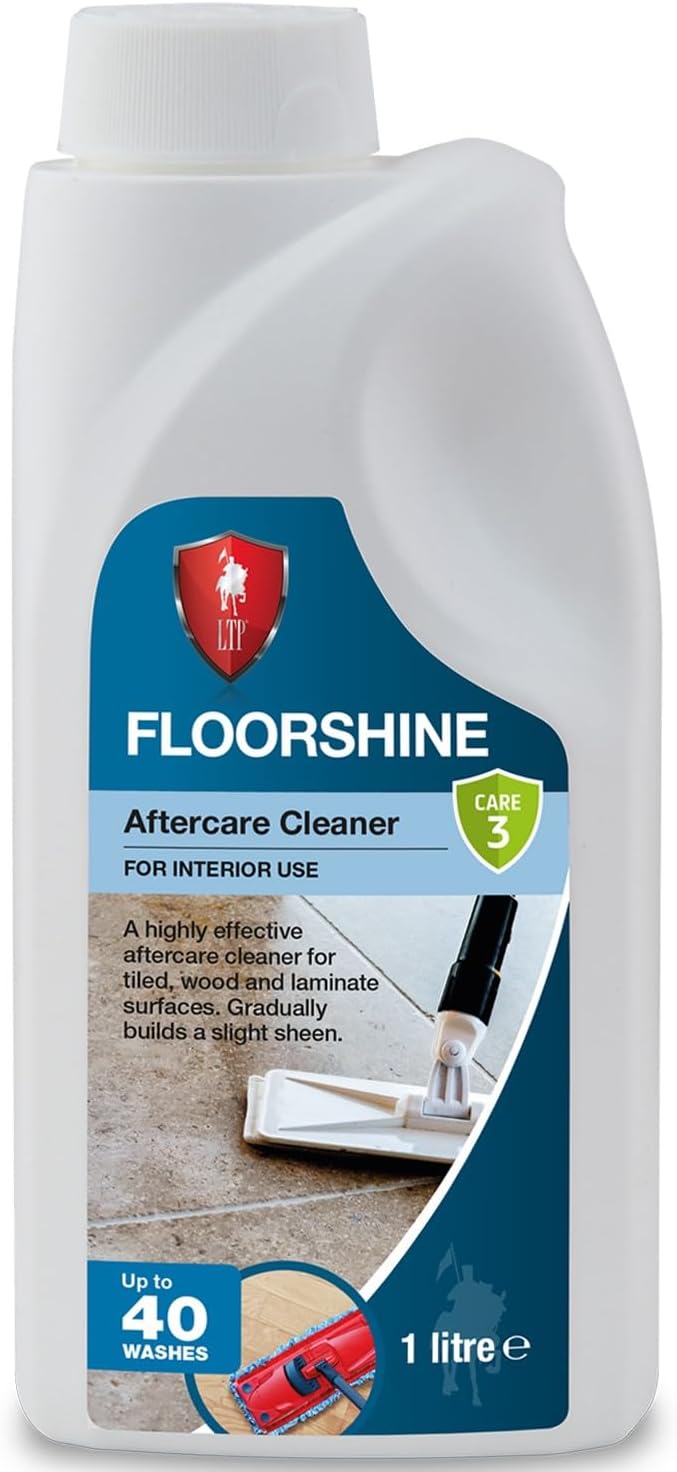
LTP Floorshine
|
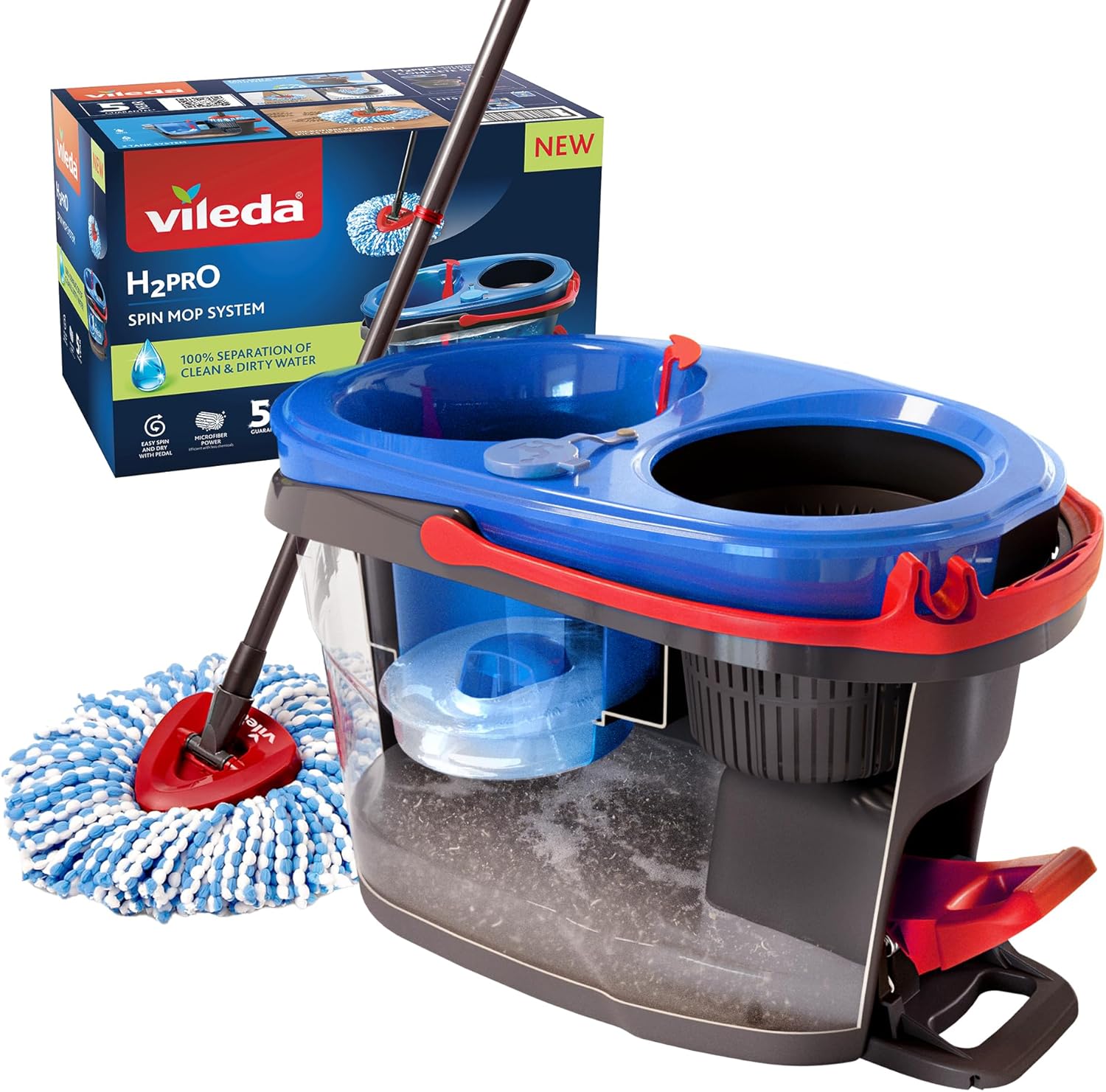
Vileda H2PrO Spin Mop System
|
Explore the Environmental Factors Leading to Fading in Quarry Tiles
Quarry tiles located in outdoor environments face a relentless barrage of environmental stressors that gradually diminish their colour and texture. While these tiles are celebrated for their durability, nature has a unique ability to wear down even the most resilient surfaces over time, leading to visible transformations that can compromise both functionality and aesthetics.
Understanding the Impact of Weather on Quarry Tile Longevity
A significant contributor to fading is the exposure to weather conditions, notably from rain and freeze-thaw cycles. Rainwater can seep into the porous surface of unsealed or inadequately sealed tiles, carrying minerals and contaminants that can stain or leach colour. When temperatures drop, moisture trapped within the tile expands upon freezing, leading to micro-cracks and surface flaking. This consistent freeze-thaw cycle unveils the inner body of the tile, often made of lighter, less pigmented material, thereby accelerating the fading process.
Recognising Surface Wear and Layer Exposure in Quarry Tiles
Quarry tiles are manufactured with a dense outer layer that preserves the most vibrant colours. As this surface layer deteriorates—due to foot traffic, abrasion, or erosion—the underlying layer becomes exposed. This base layer typically consists of larger aggregate particles and displays a more inconsistent hue, resulting in a patchy appearance that lacks the richness of the original surface. The result is a noticeable transformation in the tile’s overall aesthetics, detracting from its initial charm and appeal while diminishing its value.
Evaluating the Effects of Chemical Damage from Outdoor Cleaning on Quarry Tiles
Outdoor cleaning often requires the use of powerful chemicals to address moss, algae, or dirt. Unfortunately, these potent solutions can harm sealers and strip away protective coatings. Once the sealer is compromised, the tile becomes increasingly vulnerable to staining, mineral deposits, and accelerated wear. Over time, this chemical exposure leads to fading and a lifeless surface, further detracting from the visual appeal of the tiles while complicating maintenance efforts.
Identifying Indoor Influences on the Fading of Quarry Tiles
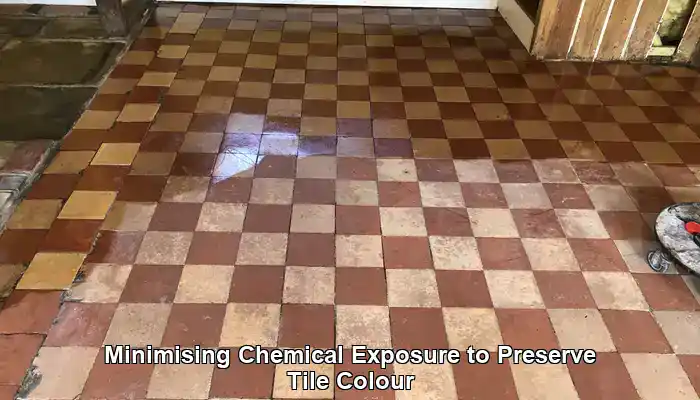
While outdoor quarry tiles are subject to environmental elements, indoor tiles face a distinct range of challenges that can also lead to deterioration over time. From the impact of foot traffic to various cleaning routines, the fading of indoor quarry tiles is often caused by a slow, cumulative process driven by wear, surface breakdown, and chemical exposure.
Assessing the Impact of Abrasive Wear and Surface Loss on Indoor Tiles
Quarry tiles are crafted with a dense, pigmented outer layer that gives them their vibrant colour and smooth finish. Indoors, particularly in high-traffic areas such as kitchens, hallways, and commercial spaces, this outer layer gradually diminishes. As the surface wears down, the inner body of the tile is revealed, typically comprising larger mineral particles and a more porous makeup. This leads to a noticeable change in colour and texture. Earth-toned tiles may begin to appear mottled or washed out, displaying lighter patches where the surface has thinned, which can significantly diminish their overall appearance and value.
Understanding the Consequences of Surface Pitting and Soil Accumulation
As the surface deteriorates, micro-abrasions and pits develop. These small indentations can trap soil, grease, and cleaning residues, resulting in uneven staining and dullness over time. Even routine cleaning may struggle to eliminate embedded dirt, leading to a faded, blotchy appearance. This issue is particularly common in older floors that have not been adequately sealed or maintained, making them more susceptible to fading and necessitating intensified restoration efforts.
Exploring the Effects of Efflorescence and Mineral Migration on Indoor Tiles
Efflorescence represents another significant factor influencing the fading of indoor tiles. This phenomenon occurs when moisture beneath the tile rises to the surface, carrying soluble salts along with it. As the moisture evaporates, it leaves behind a white, powdery residue that lightens the tile’s appearance and can potentially harm the surface. Efflorescence is particularly prevalent in areas lacking sufficient subfloor ventilation or where tiles are installed over damp concrete. If not addressed promptly, it can damage the tile’s surface and complicate cleaning tasks, leading to further visual degradation.
Examining the Consequences of Chemical Overuse and Breakdown of Sealers
Indoor cleaning practices frequently rely on strong chemical agents, especially in commercial or food preparation settings. While these products can effectively remove grease and stains, they also risk stripping away sealers and protective coatings. Once the sealer is compromised, the tile becomes more porous and vulnerable to staining, wear, and additional fading. Acidic or alkaline cleaners can even etch the surface, permanently altering its texture and colour. Over time, repeated exposure to harsh chemicals accelerates the deterioration of both the tile and its finish, increasing the need for frequent maintenance and repairs.
Discovering Maintenance Practices That Enhance the Longevity of Quarry Tiles
Preventing the fading of indoor quarry tiles is often achievable through diligent maintenance. Using pH-neutral cleaners, adhering to a regular sealing schedule, and avoiding abrasive tools can significantly prolong the life and aesthetic appeal of the tiles. For older floors showing signs of wear, professional restoration—including deep cleaning, re-sealing, and colour enhancement—can effectively rejuvenate their original beauty and vibrancy, restoring them to like-new condition.
Exploring the Most Effective Techniques for Preventing and Restoring Quarry Tiles
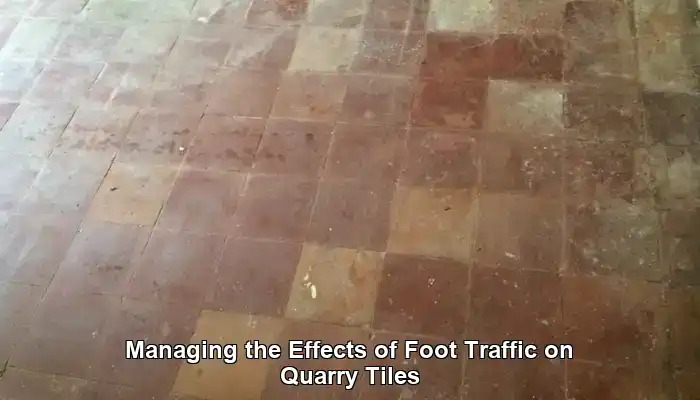
Understanding the reasons behind quarry tile fading is only part of the solution—the true value lies in knowing how to prevent fading and restore their original beauty when wear occurs. Whether your tiles are installed indoors or outdoors, proactive care and thoughtful restoration can significantly prolong their lifespan while preserving their rich, earthy character, ensuring they remain a beautiful feature in your home or business.
Exploring How Sealing Acts as the Primary Defence Against Fading
One of the most effective methods to prevent fading is through proper sealing. Quarry tiles are inherently porous, and without a protective barrier, they readily absorb moisture, dirt, and chemicals. A high-quality penetrating sealer fills the pores without forming a surface film, allowing the tile to breathe while repelling contaminants. This is especially critical for outdoor tiles to protect against rain, frost, and algae. Indoors, sealing is essential to resist staining from spills, cleaning products, and foot traffic, helping to maintain their beauty for years.
Sealers should be reapplied periodically—generally every 1 to 3 years, depending on usage and exposure levels. A simple water-drop test can help determine when resealing is necessary: if water soaks in rather than beads on the surface, it’s time for a refresh to ensure ongoing protection.
Understanding the Benefits of Using the Right Cleaning Products for Quarry Tiles
Routine cleaning is crucial, but the cleaning agents you choose can significantly influence the longevity of your quarry tiles. Harsh chemicals, particularly acidic or alkaline cleaners, can degrade sealers and etch the tile surface. Over time, this can lead to dullness, discolouration, and increased susceptibility to staining. Instead, opt for pH-neutral cleaners specifically formulated for stone or tile surfaces. These products effectively lift dirt without compromising the integrity of the tile, thereby prolonging their lifespan.
For stubborn grime or efflorescence, use targeted treatments sparingly, ensuring to follow with a thorough rinse. Avoid bleach, ammonia, and vinegar-based solutions, which may seem effective but can cause long-term damage and contribute to further fading.
Identifying Maintenance Techniques to Protect the Colour of Quarry Tiles
Regular sweeping and damp mopping are essential habits that help prevent soil accumulation and surface abrasion. Utilise soft-bristle brushes or microfiber pads instead of abrasive scrubbers that can wear down the tile’s pigmented layer. In high-traffic areas, consider using rugs or mats to reduce direct wear—especially near entryways or kitchen workstations, which are prone to heavy foot traffic.
When it comes to outdoor tiles, pressure washing should be approached with caution. While effective for removing surface dirt, excessive pressure may damage the tile or force water into cracks, worsening freeze-thaw damage. If pressure washing is necessary, maintain low pressure and keep the nozzle at a safe distance from the tile surface to prevent potential harm.
Discovering How Professional Restoration Can Revive Quarry Tiles
When fading becomes evident and routine care proves inadequate, professional restoration can yield remarkable results. Restoration specialists employ a combination of deep cleaning, mechanical resurfacing, and colour enhancement techniques to rejuvenate worn tiles, providing a fresh look and feel.
- Deep cleaning effectively removes embedded dirt, grease, and mineral deposits using specialized equipment and solutions, revitalising the tile’s original vibrancy.
- Mechanical honing or polishing smooths worn surfaces and restores texture, particularly for indoor tiles that show signs of surface pitting, enhancing their overall finish.
- Colour enhancement sealers can enrich faded tones, especially in earth-coloured tiles, by deepening their natural pigments without creating a glossy finish that detracts from their authentic look.
In instances of significant wear, restoration may also involve regrouting, tile replacement, or applying protective coatings suited to the tile’s specific environment, ensuring long-lasting results and satisfaction.
Formulating a Long-Term Care Strategy for Quarry Tiles
Preventing future fading necessitates a comprehensive long-term strategy. Establish a maintenance schedule that incorporates regular inspections, cleaning, and resealing. Educate household members or staff about appropriate cleaning techniques and the significance of using suitable products. For commercial settings, consider collaborating with a floor care professional to create a tailored plan based on traffic levels and environmental conditions to ensure optimal care.
If your tiles are part of a heritage property or hold historical significance, consult with conservation experts before commencing any restoration work. Preserving the authenticity of older quarry tiles often requires specialized techniques and materials to maintain their integrity and historical value.
Addressing Frequently Asked Questions Regarding Quarry Tile Maintenance
Is It Possible to Restore Faded Quarry Tiles Effectively?
Yes, quarry tiles can often be rejuvenated through deep cleaning, resealing, or even professional refinishing techniques, depending on the extent of fading. Homeowners should explore various options for revitalising their tiles and restoring their original vibrancy, enhancing their overall aesthetics.
What Is the Recommended Cleaning Frequency for Quarry Tiles?
Regular sweeping should be undertaken weekly, with deeper cleaning every few months to maintain their appearance and prevent fading. Establishing a consistent routine will aid in preserving their vibrancy and overall condition, ensuring they continue to look their best.
Are There Specific Sealants Formulated for Quarry Tiles?
Indeed, there are specialized sealants designed specifically for quarry tiles that provide protection against moisture and UV rays, thereby enhancing their longevity and appearance. Homeowners should consult professionals for personalized recommendations regarding sealant selection to ensure optimal results.
Which Cleaning Products Should Be Avoided on Quarry Tiles?
It is advisable to avoid using acidic cleaners, harsh chemicals, and abrasive scrubbers, as these can damage the tile surface and contribute to fading. Instead, select gentle, tile-safe cleaning products that preserve the integrity of the surface, ensuring long-lasting beauty and durability.
How Can I Determine If My Quarry Tiles Require Resealing?
If water no longer beads on the surface or if tiles appear dull and stained, it may be time to reseal them. Regular inspections can help maintain optimal protection and appearance, ensuring that your tiles remain beautiful and functional.
Does Indoor Lighting Affect Tile Fading?
Indirect indoor lighting generally has a lesser impact than UV rays, but prolonged exposure to bright light can contribute to gradual fading. Homeowners should consider lighting options when designing their spaces to minimise potential fading and maintain the integrity of their tiles.
Can I Use a Steam Cleaner on Quarry Tiles?
Steam cleaners may be too harsh for quarry tiles, potentially harming their surface. It is advisable to stick to recommended cleaning methods to maintain the integrity and appearance of the tiles while ensuring their longevity.
Are Certain Quarry Tiles More Prone to Fading Than Others?
Yes, tiles made from inferior materials or pigments may fade more quickly compared to those crafted from higher-quality materials. Homeowners should prioritise quality in their tile selection to ensure longevity and resistance to fading, thereby protecting their investment.
Does Foot Traffic Impact the Lifespan of Quarry Tiles?
High foot traffic can lead to accelerated wear and tear, hastening fading and increasing maintenance requirements. Homeowners should implement strategies to effectively manage foot traffic and protect their tiles, ensuring they remain in excellent condition over time.
Is It Possible to Fully Prevent Fading in Quarry Tiles?
While completely preventing fading is challenging, regular maintenance, proper sealing, and selecting quality products can significantly reduce colour loss over time, preserving the tiles’ beauty and ensuring they remain a stunning feature in your space.
The Article Why Do Some Quarry Tiles Fade Over Time: A Guide first found on https://www.abbeyfloorcare.co.uk
The Article Quarry Tiles Fade: Understanding the Causes and Solutions appeared first on https://fabritec.org
The Article Quarry Tiles Fade: Causes and Effective Solutions Explained Was Found On https://limitsofstrategy.com



